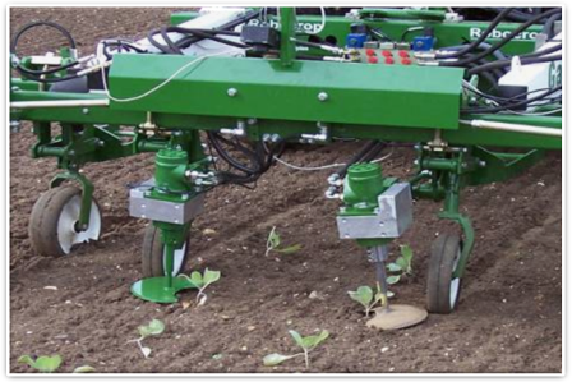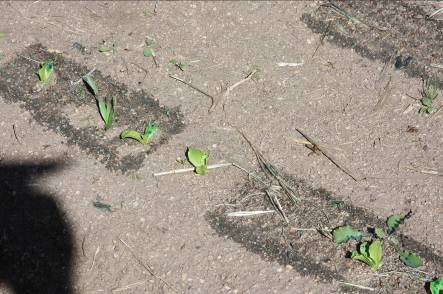Machine-Guided Cultivation to Control Weeds in Field-Grown Cut Flowers
by Richard Smith, Steve Fennimore and Laura Tourte
Growers strive to improve crop production and harvest efficiency as well as crop yield and quality. Barriers to achieving these goals include the availability of registered herbicides and the accessibility and cost of labor for weed control. The accessibility and cost of labor is greatly affected by State or Federal immigration policy and the economy; the availability of registered herbicides is affected by the chemical registrants’ expected sales revenues (which may be low for specialty crops and may not offset registration costs) and projected liability to the registrant if the crop is injured by the herbicides, as well as environmental issues. Immigration policy, the economy and pesticide registration decisions are factors that are difficult or impossible for growers to control or influence. Fortunately, labor issues and the availability of herbicides are less of a hindrance to weed control when growers adopt new technologies that can increase labor-use efficiency.
The application of computer technology to row crop production has been an active area of research and development, and has made significant progress with respect to weed control. Mechanical weed control machines are becoming available that utilize cameras to detect crop plants on a bed. The camera then sends an image of the bed to a computer, which analyzes the data and records the location of crop plants on each bed. Present technology relies on size differences between the crop and the weeds. Computer-assisted mechanical weed control machines are therefore more effective when used on transplanted crops than direct-seeded because transplanted crops are initially larger than the weeds that emerge after planting. Once crop plants are recognized, the machines use a variety of techniques to remove the weeds from the seed line: swinging, spinning, or opening and closing blades, or other techniques such as flaming and the use of timed chemical sprays. All of these mechanisms are designed to avoid crop plants and remove weeds between the crop plants in the seed line. Currently, there are two notable computer-assisted mechanical weed control machines either on the market or close to being commercialized for row crop production. In the following two examples, we describe these machines and our efforts to evaluate efficacy or provide a demonstration opportunity for growers.

Fig. 1. The Tillet Weeder is a commercially available mechanical weed control machine that uses computer technology and a spinning blade to remove weeds. Note the disc-shaped cultivation blade with a notched cut-out to allow the blade to spin around transplanted cabbage.
Example 1
In 2009 and 2010 we evaluated a commercially available unit, the Tillet Weeder, which is fabricated in England (Garford Corp, http://garford.com/). This computer-assisted mechanical weed machine uses a spinning blade with a notched cut-out on one side. The blade travels in the seed line removing weeds, but when it encounters a crop plant, it spins around it by placing the plant in the notch (fig. 1). We evaluated the efficacy of this machine for weed control, crop safety and impact on hand weeding in trials on leafy green vegetables and tomatoes as compared to standard cultivation with knives and sweeps, which do not remove weeds from the band that is left around the seed line. In one trial with transplanted radicchio, the Tillet removed 64% of the weeds in the seed line and reduced subsequent hand-weeding time by 3.7 hours per acre (table 1). The mechanical action of the Tillet in this trial did not reduce the stand or the yield of radicchio. In contrast, in direct-seeded lettuce, although the Tillet Weeder reduced weed densities by 69% and hand-thinning times by 24% compared to the standard cultivator, the crop yield in the Tillet cultivator treatments were 11.7% less than the standard cultivator treatments. The Tillet cultivator worked much better in transplanted lettuce, where hand-weeding times were only10% less than in the standard cultivator treatments, but lettuce yields were not affected by cultivator type (data for lettuce are not shown).
Table 1. Effect of the Tillet Weeder on weed control, hand-weeding time and crop yield in transplanted radicchio in 2009. Weed counts pre- and post- cultivation were made in the seed line only — the standard cultivation does not remove weeds in the seed line.
|
Treatment
|
Pre-cultivation |
Post-cultivation weed counts |
Percent |
Hand |
Hand |
Total |
Stand |
Stand |
Yield |
Yield |
|
Total |
Total |
% |
hr/A |
hr/A |
hr/A |
Plant/A |
Plant/A |
lbs/head |
tons/A
|
|
|
Standard |
40.3 |
NA |
NA |
8.4 |
6.9 |
15.3 |
31,245 |
29,628 |
0.84 |
12.4 |
|
Tillet |
47.6 |
16.9 |
64 |
5.9 |
5.7 |
11.6 |
30,721 |
29,119 |
0.88 |
12.7 |
|
Pr>F treat |
0.242 |
NA |
NA |
<0.001 |
0.005 |
<0.001 |
0.318 |
0.278 |
0.448 |
0.657 |
|
Pr>F block |
0.06 |
NA |
NA |
0.616 |
0.061 |
0.156 |
0.221 |
0.073 |
0.251 |
0.447 |
|
LSD 0.05 |
NS |
NA |
NA |
0.7 |
0.8 |
1.3 |
NS |
NS |
NS |
NS |
In most of our trials for direct-seeded and transplanted lettuce and tomatoes, the Tillet was able to reduce thinning and hand-weeding costs per acre between 15 and 30% over standard cultivation. However, as previously mentioned, the Tillet also reduced yields in a number of trials, resulting in lower net returns to growers. Some fine-tuning of this technology would be helpful in minimizing yield reductions, which in turn may improve net returns to growers. Comparable savings in thinning and hand-weeding costs observed in these trials may be achieved in field-grown flowers if they are planted in bed configurations that are similar to the plant spacing used in the evaluated vegetable crops (double rows on 40-inch beds with 10 to 12 inches between plants in the seed line). Attention to total yield and net returns must be factored into any decision for use of this technology.
Example 2
In May, 2011 we held a field day demonstrating a second type of technology that is soon to be commercially available which is a prototype of an automated weeder/thinner developed by the University of Arizona and Mule Deer Automation (New Mexico). Instead of using a blade to remove weeds as in the Tillet cultivator example, this machine sprays a chemical in a band application to remove unwanted plants. Various chemicals can be used in this machine such as acid or salt-based fertilizers (e.g., phosphoric acid or ammonium nitrate [see fig. 2] ) or herbicides such as paraquat or pelargonic acid (Scythe®); organic herbicides can also be used. A number of growers at the field day expressed interest in testing and buying this machine when it becomes commercially available.

Fig. 2. Lettuce thinned and weeded with the University of Arizona/Mule Deer Automation prototype. The unwanted plants were treated with ammonium nitrate (AN20) fertilizer (in dark gray rectangular areas) and will die in a matter of days.
Conclusion
In general, computer-assisted mechanical weed control machines will continue to develop and improve in the coming years. This technology has been shown to be useful to vegetable crops and could be used in field-grown cut flower production as well because many of the production practices (e.g., bed configuration and spacing, plant density per acre) are similar. Computer-assisted mechanical weed control machines can provide an alternative option for weed control that reduces the need and cost for labor, as well as help growers cope with the limited availability and loss of effective herbicides due to regulation constraints and issues.
Richard Smith is Vegetable Crops and Weed Science Farm Advisor, UC Cooperative Extension, Monterey County; Steve Fennimore is Extension Vegetable Weed Specialist, Department of Plant Sciences, UC Davis; and Laura Tourte is County Director and Farm Management/Small Farms Farm Advisor, UC Cooperative Extension, Santa Cruz County.












